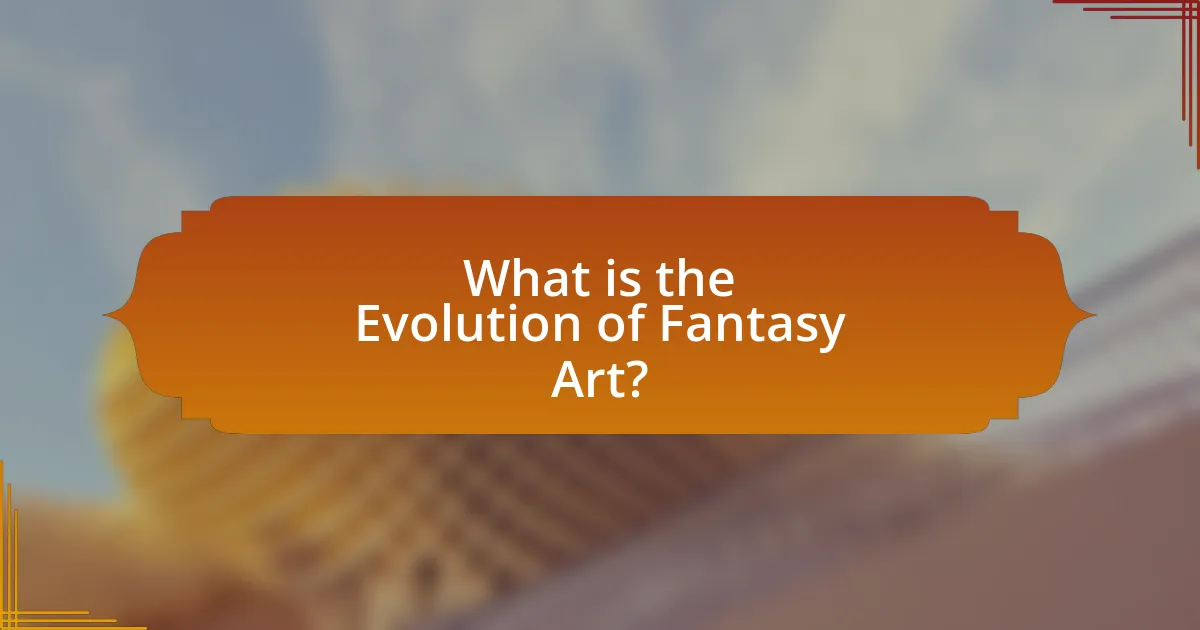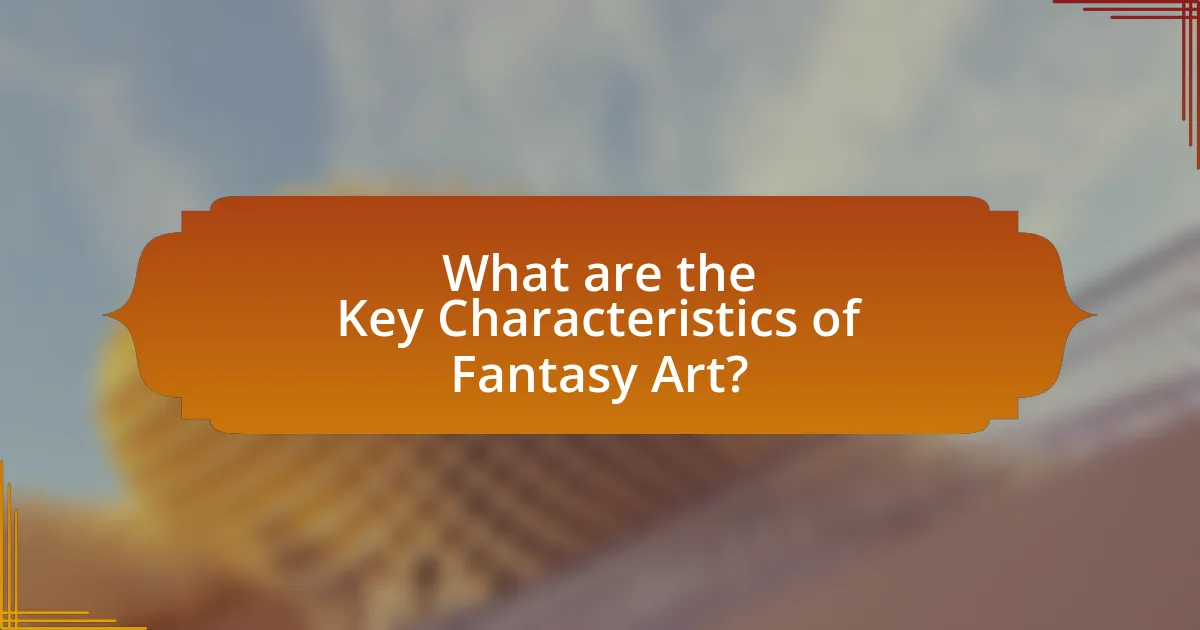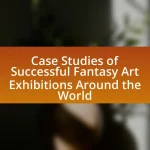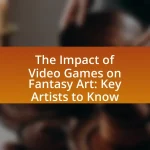The article examines the evolution of fantasy art, tracing its development from early mythological illustrations to contemporary digital creations. It highlights key artistic movements such as Romanticism, Symbolism, and Surrealism, and discusses the influence of iconic artists like Frank Frazetta, Boris Vallejo, and Julie Bell on the genre. The article also explores how cultural shifts impact themes in fantasy art, the significance of its history, and the role of fantasy art in popular culture. Additionally, it addresses the techniques and styles that have emerged over time, providing insights for aspiring artists on developing their unique styles and accessing learning resources.

What is the Evolution of Fantasy Art?
The evolution of fantasy art spans several centuries, beginning with early mythological illustrations and progressing through various artistic movements. Initially, fantasy art was influenced by medieval manuscripts and religious iconography, where artists depicted mythical creatures and divine beings. The Romantic period in the 19th century saw a surge in fantasy themes, with artists like Gustave Doré illustrating literary works such as Dante’s “Divine Comedy,” which showcased elaborate fantastical imagery.
In the 20th century, the rise of pulp magazines and comic books popularized fantasy art further, with artists like Frank Frazetta and Boris Vallejo creating iconic covers that defined the genre. The advent of digital technology in the late 20th and early 21st centuries transformed fantasy art, allowing artists to create intricate works using software, leading to a new wave of creativity and accessibility. This evolution reflects the changing cultural landscape and the growing appreciation for fantasy as a legitimate art form, evidenced by the increasing presence of fantasy art in galleries and exhibitions worldwide.
How has fantasy art changed over the decades?
Fantasy art has evolved significantly over the decades, transitioning from traditional illustrations to digital creations. In the 1970s and 1980s, fantasy art was primarily characterized by detailed paintings and illustrations, often influenced by artists like Frank Frazetta and Boris Vallejo, who popularized a muscular, heroic aesthetic. The 1990s saw the rise of fantasy art in gaming, with artists like Larry Elmore contributing to the visual identity of role-playing games, emphasizing vibrant colors and dynamic compositions.
Entering the 2000s, the advent of digital tools transformed the medium, allowing artists to experiment with new techniques and styles, as seen in the works of artists like Donato Giancola and Julie Bell. This shift not only expanded the accessibility of fantasy art but also diversified its themes, incorporating elements from various cultures and contemporary issues. By the 2010s, social media platforms enabled artists to reach wider audiences, leading to a proliferation of styles and sub-genres, including webcomics and fan art, which further democratized the creation and appreciation of fantasy art.
Overall, the evolution of fantasy art reflects broader technological advancements and cultural shifts, showcasing a dynamic interplay between tradition and innovation.
What key movements have influenced the evolution of fantasy art?
Key movements that have influenced the evolution of fantasy art include Romanticism, Symbolism, Surrealism, and the rise of digital art. Romanticism, which emerged in the late 18th century, emphasized emotion and individualism, inspiring artists like John William Waterhouse to create fantastical scenes. Symbolism, prevalent in the late 19th century, focused on representing ideas through symbolic imagery, influencing artists such as Gustave Moreau. Surrealism, which gained prominence in the early 20th century, introduced dream-like and bizarre elements, impacting artists like Salvador Dalí and Max Ernst. The advent of digital art in the late 20th century revolutionized fantasy art, allowing for new techniques and broader accessibility, as seen in the works of contemporary artists like H.R. Giger and Yoshitaka Amano. Each of these movements contributed distinct styles and philosophies that shaped the visual language of fantasy art.
How do cultural shifts impact the themes in fantasy art?
Cultural shifts significantly impact the themes in fantasy art by reflecting societal values, beliefs, and concerns. For instance, the rise of environmentalism in the late 20th century led to an increase in fantasy artworks that emphasize nature, mythical creatures, and ecological themes, as seen in the works of artists like Brian Froud. Additionally, the representation of gender roles in fantasy art has evolved, with contemporary artists challenging traditional portrayals of women, as evidenced by the works of artists such as Julie Bell, who depict strong female characters. These changes illustrate how fantasy art serves as a mirror to the evolving cultural landscape, adapting to and often critiquing the prevailing social narratives.
Why is the history of fantasy art significant?
The history of fantasy art is significant because it reflects cultural values, societal changes, and the evolution of imagination throughout different periods. Fantasy art has served as a medium for artists to explore themes of mythology, folklore, and the human experience, influencing literature, film, and gaming. For instance, the works of artists like Frank Frazetta and Boris Vallejo in the 20th century not only shaped the visual representation of fantasy but also impacted the broader genre, leading to the popularization of fantasy in mainstream media. This historical context demonstrates how fantasy art has been a crucial element in the development of creative expression and cultural storytelling.
What role does fantasy art play in popular culture?
Fantasy art plays a significant role in popular culture by shaping visual storytelling and influencing various media, including films, video games, and literature. This genre of art provides a rich visual language that enhances the imaginative experience, allowing audiences to engage with fantastical worlds and characters. For instance, the works of artists like Frank Frazetta and Boris Vallejo have not only defined the aesthetic of fantasy art but have also inspired blockbuster films such as “The Lord of the Rings” and video games like “Dungeons & Dragons.” The impact of fantasy art is evident in its ability to create iconic imagery that resonates with fans, fostering a sense of community and shared cultural identity among enthusiasts.
How does understanding its evolution enhance appreciation of the genre?
Understanding the evolution of fantasy art enhances appreciation of the genre by providing context for its stylistic and thematic developments. As fantasy art has transitioned from early illustrations in literature to contemporary digital creations, each phase reflects cultural shifts, technological advancements, and artistic innovations. For instance, the influence of iconic artists like Frank Frazetta and H.R. Giger showcases how their unique styles contributed to the genre’s visual language, allowing audiences to recognize and value the diversity within fantasy art. This historical perspective fosters a deeper connection to the artwork, as viewers can trace the lineage of ideas and techniques that have shaped the genre over time.
![]()
Who are the Iconic Artists in Fantasy Art?
Iconic artists in fantasy art include Frank Frazetta, Boris Vallejo, and Julie Bell. Frank Frazetta is renowned for his dynamic compositions and muscular figures, significantly influencing the genre since the 1960s. Boris Vallejo is celebrated for his hyper-realistic depictions of fantasy characters, often featured on book covers and posters, while Julie Bell, known for her collaboration with Vallejo, combines traditional painting techniques with a modern aesthetic. These artists have shaped the visual language of fantasy art, establishing a legacy that continues to inspire contemporary creators.
What contributions have iconic artists made to the genre?
Iconic artists have significantly shaped the genre of fantasy art through their innovative techniques and unique styles. For instance, artists like Frank Frazetta revolutionized the portrayal of fantasy characters with dynamic compositions and muscular forms, influencing the visual language of fantasy illustration in the 20th century. Similarly, Boris Vallejo’s hyper-realistic depictions of mythical creatures and heroic figures set a new standard for detail and realism in fantasy art. These contributions not only defined the aesthetic of the genre but also inspired countless artists and creators, leading to the proliferation of fantasy art in various media, including books, films, and video games.
Which artists are considered pioneers in fantasy art?
Artists considered pioneers in fantasy art include Frank Frazetta, Boris Vallejo, and H.R. Giger. Frank Frazetta is renowned for his dynamic compositions and muscular figures, which significantly influenced the visual language of fantasy illustration in the 20th century. Boris Vallejo is known for his hyper-realistic depictions of fantasy characters, contributing to the genre through his work in book covers and magazines. H.R. Giger’s unique biomechanical style has left a lasting impact on both fantasy and science fiction art, particularly through his design work for the “Alien” film series. These artists have shaped the evolution of fantasy art through their distinctive styles and contributions to popular culture.
How have contemporary artists shaped modern fantasy art?
Contemporary artists have significantly shaped modern fantasy art by integrating diverse cultural influences and innovative techniques. Artists like Yoshitaka Amano and James Jean have expanded the visual language of fantasy through their unique styles, blending traditional and digital mediums. For instance, Amano’s work on the “Final Fantasy” series combines intricate line work with ethereal color palettes, influencing the aesthetic of video game art. Similarly, Jean’s illustrations often merge surrealism with pop culture elements, pushing the boundaries of fantasy art into new realms. This evolution reflects a broader trend where contemporary artists draw inspiration from global narratives, resulting in a richer, more inclusive representation of fantasy themes.
Why are these artists influential in the fantasy art community?
These artists are influential in the fantasy art community because they have significantly shaped the visual language and thematic elements of the genre. Their unique styles and innovative techniques have inspired countless artists and defined the aesthetic standards within fantasy art. For instance, artists like Frank Frazetta and Boris Vallejo are known for their dynamic compositions and muscular figures, which have become iconic representations of fantasy imagery. Their works have not only influenced other artists but have also permeated popular culture, leading to a broader acceptance and appreciation of fantasy art in various media, including film and video games.
What techniques and styles have they popularized?
Iconic artists in fantasy art have popularized techniques such as digital painting, photobashing, and traditional illustration methods. Digital painting allows for a wide range of textures and effects, enabling artists to create intricate and vibrant worlds, as seen in the works of artists like Donato Giancola. Photobashing, a technique that combines photography with digital painting, has been effectively utilized by artists like Craig Mullins to create realistic environments quickly. Traditional illustration methods, including watercolor and oil painting, have also been embraced by artists like Brian Froud, who is known for his detailed and whimsical depictions of fantasy creatures. These techniques have significantly influenced the visual language of fantasy art, making it more accessible and diverse.
How do their works reflect the evolution of fantasy art?
The works of iconic fantasy artists reflect the evolution of fantasy art through their innovative techniques, thematic depth, and stylistic diversity. For instance, artists like Frank Frazetta and Boris Vallejo introduced dynamic compositions and muscular figures that emphasized action and emotion, marking a shift from earlier, more static representations. Their use of vibrant colors and dramatic lighting techniques influenced the visual language of fantasy art, making it more immersive. Additionally, contemporary artists such as Julie Bell and Donato Giancola incorporate digital tools and mixed media, showcasing the integration of technology in art creation. This progression from traditional to digital mediums illustrates the adaptability of fantasy art to cultural and technological changes, highlighting its ongoing evolution.

What are the Key Characteristics of Fantasy Art?
The key characteristics of fantasy art include imaginative themes, vibrant colors, and the depiction of mythical creatures and fantastical landscapes. Fantasy art often features elements that defy the laws of nature, such as dragons, fairies, and otherworldly settings, which transport viewers to realms beyond reality. Additionally, the use of intricate details and elaborate designs enhances the sense of wonder and escapism inherent in the genre. Historical examples, such as the works of artists like Frank Frazetta and Boris Vallejo, showcase these characteristics through their dynamic compositions and rich storytelling, solidifying fantasy art’s unique place in the art world.
How do visual elements define fantasy art?
Visual elements define fantasy art through the use of imaginative imagery, vibrant colors, and intricate details that evoke a sense of wonder and otherworldliness. These elements create a visual narrative that transports viewers to fantastical realms, often featuring mythical creatures, enchanted landscapes, and heroic figures. For instance, artists like Frank Frazetta and Boris Vallejo utilize dynamic compositions and dramatic lighting to enhance the emotional impact of their works, reinforcing the genre’s themes of adventure and escapism. The distinct visual style, characterized by exaggerated forms and surreal environments, serves to distinguish fantasy art from other artistic genres, making it a unique form of expression that captivates audiences.
What role do color and composition play in fantasy art?
Color and composition are fundamental elements in fantasy art, as they significantly influence the emotional impact and narrative clarity of the artwork. Color establishes mood and atmosphere; for instance, vibrant colors can evoke excitement and wonder, while darker tones may create a sense of mystery or foreboding. Composition, on the other hand, guides the viewer’s eye and organizes elements within the artwork, ensuring that the focal points are effectively highlighted.
For example, the use of the rule of thirds in composition can enhance the storytelling aspect by placing key elements at strategic points, drawing attention to important characters or scenes. Historical evidence shows that artists like Frank Frazetta utilized bold colors and dynamic compositions to create iconic fantasy imagery that resonates with audiences, demonstrating the critical role these elements play in conveying themes and emotions in fantasy art.
How do fantasy art styles differ from other art genres?
Fantasy art styles differ from other art genres primarily through their emphasis on imaginative and otherworldly themes, often depicting mythical creatures, magical landscapes, and surreal elements. Unlike realism, which focuses on accurate representations of the physical world, fantasy art prioritizes creativity and the exploration of the fantastical, allowing for a broader range of expression and interpretation. This genre often incorporates elements from folklore, mythology, and literature, distinguishing it from genres like abstract or modern art, which may prioritize form and color over narrative content. The unique characteristics of fantasy art can be traced back to iconic artists such as Frank Frazetta and Boris Vallejo, who have significantly shaped the genre by blending traditional techniques with imaginative storytelling, thus reinforcing the distinctiveness of fantasy art within the broader art landscape.
What themes are commonly explored in fantasy art?
Common themes explored in fantasy art include mythology, heroism, nature, and the supernatural. Mythology often serves as a foundation, drawing from ancient stories and legends to create rich, imaginative worlds. Heroism is frequently depicted through characters embarking on epic quests, showcasing bravery and moral dilemmas. Nature is represented in fantastical landscapes, emphasizing the beauty and mystery of the natural world. The supernatural theme encompasses magical creatures, otherworldly beings, and elements that defy the laws of physics, reflecting humanity’s fascination with the unknown. These themes are prevalent in the works of iconic fantasy artists, such as Frank Frazetta and Brian Froud, who have significantly influenced the genre.
How do mythology and folklore influence fantasy art narratives?
Mythology and folklore significantly influence fantasy art narratives by providing rich, symbolic content and archetypal characters that artists draw upon to create immersive worlds. These narratives often incorporate themes, motifs, and figures from various cultural mythologies, such as Greek, Norse, and Native American traditions, which serve as foundational elements in the storytelling of fantasy art. For instance, the use of mythical creatures like dragons and gods not only enhances the visual appeal but also adds layers of meaning and cultural resonance, allowing viewers to connect with the artwork on a deeper level. This connection is evident in the works of iconic fantasy artists like Frank Frazetta and Brian Froud, who have utilized folklore elements to craft compelling narratives that resonate with audiences, demonstrating the enduring impact of these traditional stories on contemporary fantasy art.
What are the common motifs found in fantasy art?
Common motifs found in fantasy art include mythical creatures, enchanted landscapes, and heroic figures. These elements often depict dragons, fairies, and wizards, which are staples in the genre, showcasing the imagination and creativity inherent in fantasy. Additionally, fantasy art frequently features themes of adventure and conflict, illustrated through epic battles or quests. The use of vibrant colors and intricate details enhances the otherworldly atmosphere, making the art visually captivating. Historical examples, such as the works of artists like Frank Frazetta and Boris Vallejo, exemplify these motifs, solidifying their significance in the evolution of fantasy art.
What are some best practices for aspiring fantasy artists?
Aspiring fantasy artists should focus on developing their unique style while mastering foundational skills in drawing and painting. Practicing regularly enhances technical abilities, and studying anatomy, perspective, and color theory provides a solid base for creating believable fantasy worlds. Engaging with the fantasy art community through social media platforms and forums fosters networking opportunities and constructive feedback, which are crucial for growth. Additionally, analyzing the works of iconic fantasy artists, such as Frank Frazetta and Brian Froud, can inspire and inform personal artistic choices. These practices are supported by the fact that consistent practice and community engagement are widely recognized as key factors in artistic development.
How can artists develop their unique style in fantasy art?
Artists can develop their unique style in fantasy art by experimenting with various techniques, themes, and influences while consistently refining their personal vision. Engaging with diverse artistic movements, studying the works of iconic fantasy artists, and incorporating elements from different genres can help artists identify what resonates with them. For instance, artists like Frank Frazetta and Brian Froud have distinct styles that emerged from their unique interpretations of fantasy themes, showcasing the importance of personal expression and innovation. Additionally, regular practice and seeking feedback from peers can further enhance an artist’s ability to cultivate a recognizable style.
What resources are available for learning fantasy art techniques?
Resources available for learning fantasy art techniques include online platforms, books, and workshops. Websites like Skillshare and Udemy offer courses specifically focused on fantasy art, taught by experienced artists. Books such as “Fantasy Art Workshop” by John Howe and “The Art of Fantasy” by various authors provide foundational knowledge and techniques. Additionally, attending workshops or conventions, such as the Spectrum Fantastic Art Live, allows artists to learn directly from professionals in the field. These resources collectively enhance skills in creating fantasy art.

